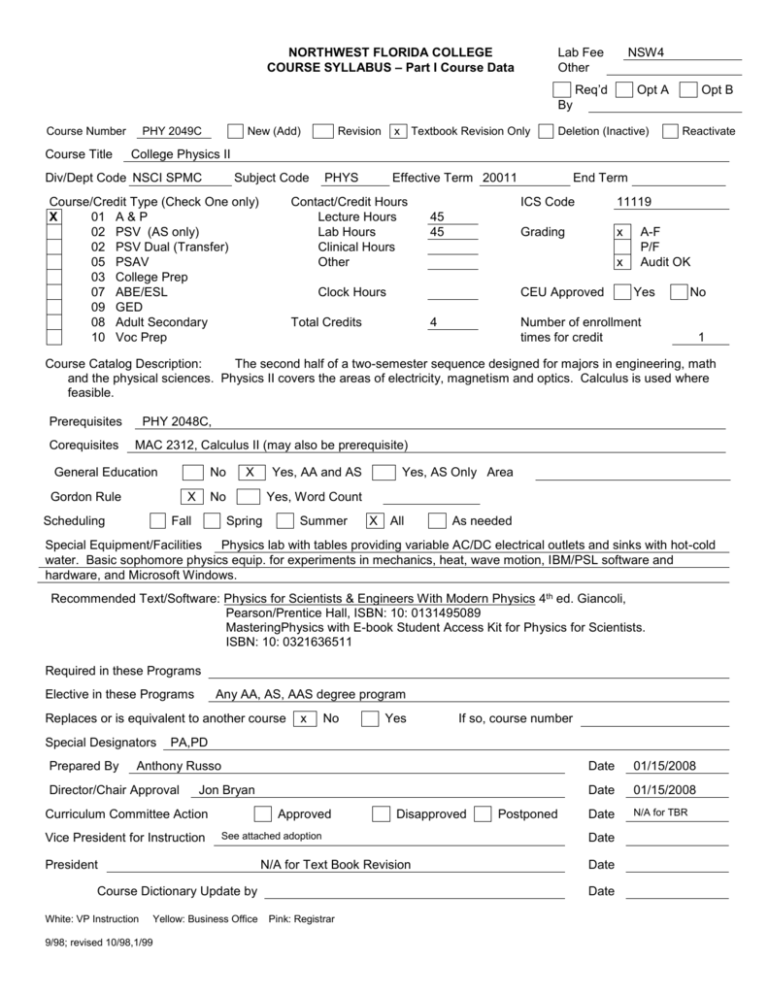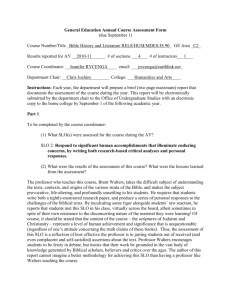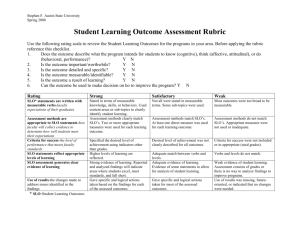
NORTHWEST FLORIDA COLLEGE
COURSE SYLLABUS – Part I Course Data
Lab Fee
Other
NSW4
Req’d
Opt A
Opt B
By
Course Number
Course Title
PHY 2049C
New (Add)
Revision
x Textbook Revision Only
Deletion (Inactive)
Reactivate
College Physics II
Div/Dept Code NSCI SPMC
Subject Code
Course/Credit Type (Check One only)
X
01 A & P
02 PSV (AS only)
02 PSV Dual (Transfer)
05 PSAV
03 College Prep
07 ABE/ESL
09 GED
08 Adult Secondary
10 Voc Prep
PHYS
Effective Term 20011
Contact/Credit Hours
Lecture Hours
Lab Hours
Clinical Hours
Other
45
45
End Term
ICS Code
11119
Grading
x
x
Clock Hours
CEU Approved
Total Credits
4
A-F
P/F
Audit OK
Yes
No
Number of enrollment
times for credit
1
Course Catalog Description:
The second half of a two-semester sequence designed for majors in engineering, math
and the physical sciences. Physics II covers the areas of electricity, magnetism and optics. Calculus is used where
feasible.
Prerequisites
Corequisites
PHY 2048C,
MAC 2312, Calculus II (may also be prerequisite)
General Education
No
Gordon Rule
X
Scheduling
X
Yes, AA and AS
No
Fall
Yes, AS Only Area
Yes, Word Count
Spring
Summer
X
All
As needed
Special Equipment/Facilities
Physics lab with tables providing variable AC/DC electrical outlets and sinks with hot-cold
water. Basic sophomore physics equip. for experiments in mechanics, heat, wave motion, IBM/PSL software and
hardware, and Microsoft Windows.
Recommended Text/Software: Physics for Scientists & Engineers With Modern Physics 4th ed. Giancoli,
Pearson/Prentice Hall, ISBN: 10: 0131495089
MasteringPhysics with E-book Student Access Kit for Physics for Scientists.
ISBN: 10: 0321636511
Required in these Programs
Elective in these Programs
Any AA, AS, AAS degree program
Replaces or is equivalent to another course
Special Designators
Prepared By
x
No
Yes
If so, course number
PA,PD
Anthony Russo
Director/Chair Approval
Jon Bryan
Curriculum Committee Action
Vice President for Instruction
Approved
See attached adoption
President
N/A for Text Book Revision
Course Dictionary Update by
White: VP Instruction
Disapproved
Yellow: Business Office
9/98; revised 10/98,1/99
Postponed
Date
01/15/2008
Date
01/15/2008
Date
N/A for TBR
Date
Date
Date
Pink: Registrar
COURSE SYLLABUS PART II
COURSE GOALS
Course Number PHY2049C
Prepared by
Title
College Physics II
Anthony Russo
Date
Director/Chair Jon Bryan
Criteria:
Date
01/15/2008
01/15/2008
(1) Direction oriented; (2) student oriented — written in terms of what students will accomplish; (3)
provide the lay reader with an understanding of the substance of the course; and (4) the number
of statements should be sufficient to clearly identify the mission of the course.
Goal
Number
Statement
Student Outcomes – The student will:
1.
The student will demonstrate an understanding of the basic principles of electrostatics, electricity
and magnetism and the interrelationship of electricity and magnetism.
2.
The student will demonstrate an understanding of the nature of light and basic principles of light
propagation, reflection, refraction, and diffraction.
3.
The student shall perform laboratory experiments to develop experimental techniques and to aid in
the achievement of Goals 1 and 2.
In addition to the specific course goals listed above, this course also addresses the college’s
Scientific and Quantitative Reasoning General Education Goal/Outcome through the following
Student Learning Outcomes (SLO’s):
SLO 1
The student will demonstrate fundamental knowledge of the terminology, Major concepts, and
theories of one or more fields in the physical or biological sciences.
SLO 2
The student will distinguish among fact, scientific law, hypothesis, and theory, including the
scientific method.
9/98; revised 10/98,1/99
COURSE SYLLABUS PART III
PERFORMANCE OBJECTIVES
Course Number
PHY2049C
Page
3
Date
College Physics II
4
01/15/2008
Prepared by
Course Title
of
Anthony Russo
Director/Chair
Jon Bryan
A specific objective is one in which the outcome and the level of achievement
are defined in measurable terms.
Object
Related
No.
Goals
1.
1,3
SLO 1
Objectives (Student Learning Outcomes)
Evaluation
The student will demonstrate understanding of
The students understanding will be
the behavior of electrostatic charges, know
measured by objective examination
Coulomb’s law, and understand the concept of
and/or written essay. A grade of “C”
electric fields, through experimentation and the
denotes basic competence. The
use of computer aided imagery.
specific percentage for the “C” may
vary with the instructor, but in no case
2.
1,3
SLO 1
The student will demonstrate understanding of
is a “C” awarded for less than 70%
the concepts of electric potential, capacitance,
mastery of the assignment.
and capacitors.
3.
1,3
SLO 1
The student will demonstrate understanding of
SAME AS ABOVE
the concepts and relationship of electric
current, resistance, and electromotive force.
Understand Ohm'’ law and Kirchhoff’s rules.
4
1,3
SLO 1
5.
1,3
SLO 1
The student will demonstrate understanding of
the construction and use of DC instruments.
The student will demonstrate understanding of
the basic concepts of magnetism, magnetic
fields, magnetic forces, and electro-magnetic
induction.
9/98; revised 10/98,1/99
SAME AS ABOVE
SAME AS ABOVE
Object
Related
No.
Goals
6.
1,3
SLO 1
Objectives (Student Learning Outcomes)
Evaluation
The student will demonstrate understanding of
The students understanding will be
the construction, operation and uses of
measured by objective examination
galvanometer, motors, generators and
and/or written essay. A grade of “C”
induction coils.
denotes basic competence. The
specific percentage for the “C” may
7.
1,3
SLO 1
8.
1,3
SLO 1
SLO 2
9.
1,3
SLO 1
The student will demonstrate understanding of
vary with the instructor, but in no case
the relationship of resistance, inductance and
is a “C” awarded for less than 70%
capacitance in alternating current (AC) circuits.
mastery of the assignment.
The student will demonstrate understanding of
SAME AS ABOVE
Maxwell’s theory of electromagnetic wave
production and propagation.
The student will demonstrate understanding of
SAME AS ABOVE
the laws of reflection and refraction of light.
Know the uses of reflective surfaces, prisms,
and lenses.
10.
11.
2,3
The student will demonstrate understanding of
SLO 1
the concepts of light interference & diffraction.
2,3
The student will demonstrate understanding of
SLO 1
9/98; revised 10/98,1/99
light polarization and how it is accomplished.
SAME AS ABOVE
SAME AS ABOVE









